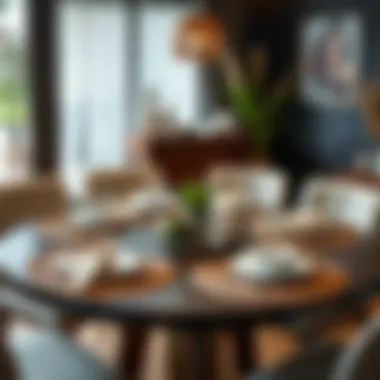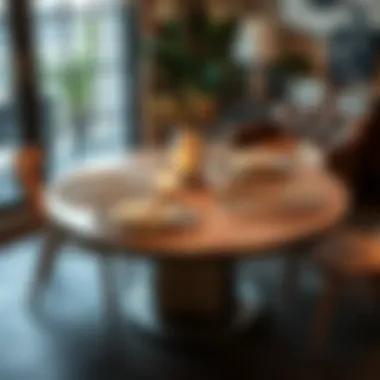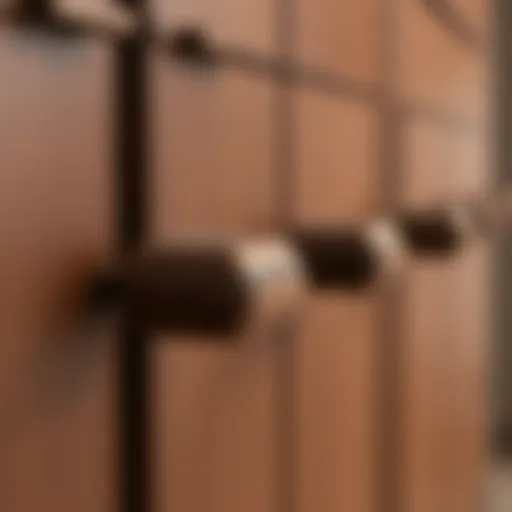Choosing the Ideal Placemats for Round Tables


Intro
Choosing the right placemat for a round table can be a bit trickier than it sounds. Unlike rectangular tables, which offer clearer delineation for placement, round tables require a different sense of style and practicality. The optimal choice not only enhances the aesthetic appeal but also ensures functionality during mealtime. Key factors like material, size, and design come into play, each contributing uniquely to setting the tone for your dining experience. This guide will unpack these elements to help you select the perfect placemat for your round table.
Furniture Styles and Trends
Modern vs. Traditional: Understanding the Aesthetics
When selecting placemats, recognizing the style of the furniture can dictate your options. Modern minimalism embraces sleek lines, often incorporating materials like bamboo or silicone. In contrast, traditional settings prefer textiles such as linen or cotton with intricate patterns or embroidery.
Choosing placemats that amplify your table's existing aesthetic not only enhances visual harmony, it also demonstrates an intuitive grasp of design principles. For instance, a geometric-patterned placemat could serve as a stylish contrast to a richly grained wooden table, creating a stunning focal point.
Color and Material Trends: What's In and What's Out
Every year brings forth new trends that dictate what’s hot and what’s not in the world of interior design. Currently, earthy tones—such as terracotta, muted greens, and warm browns—are on fire. They inject a sense of warmth and connection with nature, which can balance the coldness of typical tableware or cutlery. On the material front, sustainable options like recycled plastics and organic fabrics are gaining steam. They are not only trendy but also environmentally conscious, appealing to today’s eco-aware consumers.
Some materials, like plastic and vinyl, may give off a dated vibe. Homeowners are leaning more towards sophisticated fabrics and innovative materials that showcase a blend of form and function.
Choosing the right placemat is about more than appearance. It's an extension of your home's personality.
Furniture Care and Maintenance
Tips for Prolonging the Life of Your Furniture
While placemats can protect your table, it’s essential to take additional steps to prolong its life. Regular cleaning, appropriate placement away from direct sunlight, and using coasters for drinks can work wonders. Varnish and oil treatments can also revive tired wood surfaces, adding an extra layer of durability.
DIY Repair Hacks for Common Furniture Issues
Accidents happen, and knowing a few basic repair hacks can save you time and money. Small scratches on wooden tables can often be buffed out using a simple mixture of vinegar and olive oil. For fabric-covered tables, simple stitching can repair small rips. Always have wood glue handy for quick fixes on broken table legs or chairs.
To maintain the overall aesthetics of your dining set, remember to replace worn placemats promptly. Whether that means refreshing your collection for seasonal changes or opting for entirely new looks to suit evolving tastes, attention to detail reflects your commitment to a beautiful dining experience.
By considering these insights, you'll feel better equipped to navigate the diverse world of placemats, ensuring you enhance not just your table, but the entire dining experience for everyone who gathers around it.
Understanding the Importance of Placemats
When it comes to setting the stage for a meal, placemats may seem like a small accessory. However, their role is quite significant. They serve both functional and aesthetic purposes, enhancing the overall dining experience while also protecting your furniture. Many homeowners, designers, and DIY enthusiasts overlook the simple placemat, but understanding its importance can transform every meal into an inviting occasion.
Functional Benefits of Placemats
Protection for Table Surfaces
Placemats provide critical protection for your table. They act as a barrier against scratches, stains, and heat from hot dishes. This characteristic makes them a popular choice among households that frequently entertain guests or have young children. A good placemat can absorb liquid spills, minimizing the risk of permanent damage to your furniture.
Moreover, using placemats allows you to express your style without worrying about wear and tear. Whether it be a splatter from spaghetti sauce or the heat from a casserole dish, the right placemat keeps your table looking pristine. They come in various materials like vinyl, which is known for its easy cleanup and durability, making them an ideal choice for protecting surfaces without sacrificing style.
Ease of Cleanup
Cleaning up after a meal can sometimes feel like a chore, but the right placemats can alleviate some of that burden. Most placemats are designed for easy maintenance; simply wipe them down or toss them in the washing machine where applicable. This hassle-free aspect is beneficial for busy households and gives you one less thing to worry about during the cleanup process.
By choosing a placemat that is easy to clean, you not only save time but also ensure that your dining space remains inviting. Think about those fun family dinners—being able to simply wash your placemats instead of scrubbing your table for hours makes for a much more appealing dining experience.
Heat Resistance
In an age where cooking techniques often involve high heat, heat-resistant placemats are not just a luxury but a necessity. Choosing materials that can withstand high temperatures ensures that your table remains unscathed after serving a piping hot dish. Some mats are made from silicone or certain textiles that can provide this heat resistance, making meal serving safer and more practical.
The unique feature of heat resistance means you can place your dutch oven right from the stove onto the table without worrying about damage. It gives a comforting sense of security when serving a meal, letting you focus more on enjoying the moment rather than on avoiding damage to your furniture.
Aesthetic Contributions
Complementing Decor Styles
Placemats aren’t just about function—they also add an aesthetic flair to your dining setup. They can serve to complement existing decor styles. With options that range from rustic woven mats to sleek modern designs, there’s a placemat that can fit into any theme. Use a placemat that matches or enhances your table setting to make the dining area feel cohesive and thoughtful.
For example, a farmhouse style dining table can be elevated by using textured burlap placemats, while a sleek glass table might benefit from a set of bold, colorful mats. The right choice can easily harmonize with your existing decor, enhancing the visual appeal of your space.
Creating Visual Interest
Placemats can also become the centerpiece of your table setup, creating visual interest that can intrigue guests. Utilizing unique designs, patterns, or vibrant colors can draw attention and spark conversation. This aspect plays a significant role in how meals are perceived, enhancing the overall dining atmosphere.
For instance, a geometric pattern placemat can add a modern twist to a classic table setup, while a floral mat could introduce a nature-inspired element that softens the dining space. The imagination is the limit, and experimenting with different materials and patterns can reinvigorate your dining experience.
Color Coordination
Selecting placemats that fit into your color scheme is another way to elevate your dining experience. Thoughtful color coordination can tie together various elements of your table settings, from dishes to tablecloths. Choosing colors that either contrast attractively or complement your dining setup can have a dramatic effect on the overall look.
When your placemats match or smartly contrast with other elements on the table, they help create a well-rounded aesthetic. For example, if your dinnerware features subtle blues and greens, selecting placemats with a muted pattern in similar hues can bring harmony to the setting. This coordination of colors can also reflect seasonal changes, creating a sensory experience that complements the meal itself.
Materials Commonly Used for Placemats
Choosing the appropriate materials for placemats is crucial. These selections influence not only the overall look and feel of a dining setting, but they also play a significant role in the practicality and longevity of the placemats. The right material can offer durability, ease of cleaning, and an aesthetic that matches the decor of the room, particularly when dealing with round tables that inherently present unique challenges in placement and arrangement. This section will unpack several popular materials, examining both their benefits and limitations.
Natural Fiber Placemats
Natural fiber placemats are a popular choice due to their organic qualities and environmental benefits. Here, we'll break down three main types: Bamboo, Sisal, and Woven Grass.
Bamboo
Bamboo placemats are celebrated for their sustainability and resilience. The characteristics of bamboo make it a strong option in the realm of table decor. It has a naturally sleek finish that easily complements various dining styles, from casual brunches to formal dinners.
Advantages of Bamboo:
- Eco-friendly: Bamboo grows rapidly, making it a renewable resource.
- Easy to clean: Typically, a damp cloth suffices for upkeep.


However, it does have some drawbacks. If left in direct sunlight for too long, bamboo can fade or warp, demanding attention to placement and care.
Sisal
Sisal is made from the agave plant's fibers, providing a rustic and earthy feel. A characteristic of sisal is its sturdiness. It's often used in more rugged, informal settings where durability is vital.
Advantages of Sisal:
- Textured appearance: Adds a natural touch to dining aesthetics.
- Biodegradable: Its environmental footprint is low, appealing to eco-conscious homeowners.
On the flip side, sisal's rough texture can be less than ideal for fine dining experiences, where a smooth surface is typically preferred.
Woven Grass
Woven grass placemats offer a charm that is hard to replicate. They tend to exhibit unique patterns and colors due to their natural origins.
Advantages of Woven Grass:
- Visual diversity: Each placemat often tells its own story through patterns.
- Breathable material: Helps in maintaining a cool surface even during warm meals.
Yet, their absorbent nature means they require more care, as food spills might stain them if not addressed quickly.
Synthetic Materials
Synthetic materials bring a host of benefits, particularly in terms of durability and variety in design. This section will delve into three commonly utilized synthetic options: Polyester, PVC, and Nylon.
Polyester
Polyester placemats are known for their practicality. The material is recognized for its resistance to stains, which is a significant advantage in any dining environment.
Advantages of Polyester:
- Colorful options: Easily dyed, polyester can come in numerous shades and patterns.
- Quick drying: After cleaning, they don't take long to air dry.
However, their synthetic composition may not appeal to everyone, especially those seeking a more organic dining experience.
PVC
PVC is another widely embraced choice for placemats, especially in busy households or restaurants. It stands out for being waterproof and effortless to maintain.
Advantages of PVC:
- Durability: Can withstand considerable wear and tear, suitable for high-traffic areas.
- Versatile designs: Available in various patterns and textures, perfect for thematic settings.
That said, some may find PVC’s plastic texture undesired, as it can lack the warmth seen in natural fibers.
Nylon
Nylon combines flexibility with strength. The use of nylon placemats is increasing due to their stylish appearance and functionality.
Advantages of Nylon:
- Resistant to fraying: Maintains a fresh look even after repeated use.
- Stains are easily removable: Typically, a simple wash can do the trick.
On the downside, nylon placemats may not provide the same level of aesthetic appeal as those made from natural fibers, particularly in more rustic or traditional settings.
Fabric Placemats
Fabric placemats are popular for their versatility and elegance. The most common materials include Cotton, Linen, and Flannel.
Cotton
Cotton placemats are soft, which is a major characteristic that appeals to many diners. They are widely cherished for their versatility.
Advantages of Cotton:
- Machine washable: They are easy to clean and maintain.
- Wide design options: Available in countless colors and prints, making customization simple.
However, they can absorb liquids, leading to stains if not treated promptly.
Linen
Linen has a more upscale feel. The rough texture is offset by its elegance in dining settings.
Advantages of Linen:
- Highly durable: Holds up over time, making it a good investment.
- Softens with washing: Gains comfort with use, enhancing table experience.
Drawbacks include their propensity to wrinkle, which may be a downside for some who prefer a crisp appearance.
Flannel
Flannel placemats are softer than typical fabric options, and they provide a closeness to the texture that many find appealing.
Advantages of Flannel:
- Warm and cozy feel: Perfect for fall and winter dining atmospheres.
- Easy to clean: Washable and maintainable, generally requiring less attention.
On the flip side, flannel’s softness means it may not hold up as well against spills unless treated or layered deliberately.
Choosing the Right Size for Round Tables
Selecting the right size placemat for a round table is paramount. It’s not just about aesthetics; it's about functionality, comfort, and the overall dining experience. A properly sized placemat can enhance your table setting, allowing diners enough space to enjoy their meals without feeling cramped or disorganized. It also prevents spills and scratches on the tabletop, boosting its lifespan.


There are a few key aspects to consider when choosing the right placemat size, namely the table's diameter and the personal seating preferences that come into play.
Understanding these factors can lead to better choices that'll impress your guests and improve your everyday dining experiences.
Measuring Your Table
Diameter Considerations
Diameter considerations play a crucial role in placemat selection. A round table's diameter essentially determines how much space each placemat will occupy. The general rule of thumb is to ensure that placemats are not larger than half the table's diameter. This allows for ample table space while ensuring that every diner has their designated area to enjoy their meal.
Choosing placemats that are well-suited to the diameter creates harmony in your dining setup. Think of it this way: overly large placemats crowd the table, while too small placemats can look out of place. An ideal choice will be those that allow enough room for cutlery and dishes with a bit of breathing space to spare.
Personal Seating Preferences
Personal seating preferences should not be underestimated when selecting placemat sizes. How many people typically dine at your round table? Are there occasions when guests are added? Understanding your personal dining habits guides you toward the right size placemats.
For instance, if you entertain guests often, you might prefer larger placemats that provide extra space for serving dishes. In contrast, a family of three may find smaller placemats just fine, as they accommodate a less cluttered table setting.
The unique feature of personal preferences lies in its adaptability; as your needs change, so can your choice of placemats. This flexibility means that while there may be common dimensions, prioritizing your specific comfort and style is the way to go.
Standard Placemat Dimensions
Common Sizes for Round Tables
When it comes to common sizes for round tables, universally accepted dimensions tend to simplify the selection process. Typical placemats usually range from 14 inches to 16 inches in diameter. These dimensions generally work well for dinnerware arrangements, allowing enough space for various dining setups.
The benefit of sticking to these standard sizes is that they cater to most scenarios without overwhelming the table. However, if your table’s size is outside traditional measurements, it may require a bit more research and consideration.
Custom Sizes When Needed
Sometimes, custom sizes when needed become a necessity. When you have a unique, oversized, or otherwise uncommon round table, standard sizes simply won't cut it. Opting for custom placemats can be an intelligent choice.
Customization lets you choose not only the dimensions that fit your specific table but also delve into personal design preferences like color or texture. While the main advantage is achieving a perfect fit, it can also add a personal touch to the table setting. However, take into account the potential drawbacks, like higher costs and longer lead times when ordering tailored options.
Placemats don't just serve a functional role; they can create an atmosphere, guiding the flow of a meal and the interactions between diners. By paying attention to these dimensions, you can ensure your round table is not only beautiful but practical as well.
Exploring Different Design Styles
When selecting placemats for a round table, design plays a pivotal role not just in how the dining area looks but also in how it feels. It can set the tone for both casual meals and formal gatherings. Various design styles can evoke certain emotions or enhance the overall dining experience. This section highlights the different design styles available, providing homeowners, designers, and DIY enthusiasts a well-rounded perspective on placemat aesthetics.
Traditional Styles
Classic Patterns
Classic patterns have a certain timeless quality that appeals to many. These designs often include florals, damasks, or checkered motifs which can create an air of nostalgia. The key characteristic of classic patterns lies in their ability to blend seamlessly with a variety of decor styles, making them versatile choices for any table setting. For instance, a simple floral pattern can be a beautiful complement to a rustic wooden table, adding warmth and charm.
The unique feature of classic patterns is their historical context. They often remind one of traditional dining experiences, thus making them a popular choice for family gatherings or holiday celebrations. However, they may sometimes be perceived as outdated or overly formal in modern settings, which could restrict their usage to more traditional occasions.
Monochromatic Themes
Monochromatic themes are favored for their sleek, minimalist aesthetic. By utilizing various shades of one color, these placemats can create a cohesive look that resonates with contemporary designs. A key trait of monochromatic themes is their ability to simplify a table setting, allowing the focus to rest on the food and the overall dining experience.
One unique feature of this style is its ability to match effortlessly with other tableware. This compatibility can be particularly advantageous in homes where colors and styles may constantly evolve. However, while monochromatic designs can enhance elegance, they sometimes lack the visual interest found in more colorful designs, which might make them seem somewhat flat.
Contemporary Designs
Minimalist Approaches
Minimalist approaches to placemat design emphasize simplicity and functionality. The key characteristic here is that less is often more; these placemats tend to have clean lines and subdued colors. Such designs create a calm atmosphere, perfect for those seeking a clutter-free dining experience.
What sets minimalist placemats apart is their ability to work alongside modern furnishings without overpowering them. They are particularly beneficial for urban dwellers or renters who prefer a chic, understated look. Nevertheless, some may find them lacking personality or charm, which can be a downside for more expressive styles.
Geometric Patterns
Geometric patterns have emerged as a hot trend among modern decor enthusiasts. With bold shapes and lines, they provide a playful contrast to traditional dining aesthetics. Their key trait is versatility; they can range from subdued color palettes to bright, eye-catching designs that can add a splash of excitement to any table.
Geometric patterns are uniquely suited for eclectic dining settings. They can make a statement without much effort, allowing hosts to express their individuality. However, their bold designs might clash with more traditional decor, making careful consideration imperative for certain settings.
Bohemian and Rustic Aesthetics
Layered Textures
Layered textures in placemats offer a tactile experience that enhances the dining setting. The blend of various materials, such as lace over burlap or woven grasses, provides depth and intrigue. Key to this design aesthetic is its ability to evoke warmth and charm, creating an inviting atmosphere.
The unique feature of layered textures is their capacity to fit seamlessly into both rustic and bohemian decor styles. Such placemats often tell a story, bringing a sense of coziness to the table. On the downside, they may require more maintenance as multiple materials can complicate cleaning and care.
Natural Color Palettes
Natural color palettes breath life into dining spaces by utilizing earthy tones and soft hues. They complement various styles effortlessly—think greens, browns, and creams that echo the outdoors. This key characteristic fosters a sense of tranquility and connection to nature, which can be particularly appealing to those looking to enhance a relaxed dining atmosphere.
The unique feature of natural palettes lies in their adaptability. They can easily blend into both contemporary and traditional settings, making them an excellent choice for all types of gatherings. However, they could sometimes appear too muted or bland for those who prefer bold or vibrant designs.
Sustainability in Placemats
In today’s world, having sustainable options is crucial, especially when it comes to home goods such as placemats. Sustainability isn’t just a fleeting trend; it’s a substantial movement towards better choices for our environment. Choosing the right placemats can greatly minimize waste, conserve resources, and support ethical practices. As we dive into this section, we’ll explore how selecting sustainable placemats can elevate our dining experience while being kinder to the planet.
Eco-Friendly Materials
Recycled Fabrics
Recycled fabrics play a significant role in the sustainability equation. These materials are often made from textiles that would otherwise contribute to landfills. By repurposing these fabrics, we not only reduce waste but also save energy and other resources required for new production. The key characteristic of recycled fabrics is their ability to maintain quality while being environmentally friendly. They offer vibrant colors and unique textures, catering to the aesthetic demands of any dining space.
A unique feature of recycled fabrics is how they can often have a more textured feel compared to their virgin counterparts, which adds an element of charm. One advantage is their versatility, easily fitting various dining themes from rustic to modern. However, one potential downside is that the sustainability of these fabrics may vary depending on their sources, requiring buyers to do a bit of homework before purchasing to ensure they make a truly eco-friendly choice.


Bamboo and Cork Options
Bamboo and cork placemats have gained traction in the eco-conscious market. Bamboo, known for its rapid growth, is a renewable resource that thrives without needing harmful pesticides or fertilizers. Cork, harvested from the bark of the cork oak tree, is sustainable as it regrows after harvesting. Both materials bring a unique aesthetic appeal to any round table.
The characteristic of these materials is their natural beauty and durability. Their unique feature lies in their ability to withstand heat, making them perfect for placing hot dishes directly on the table without fear of damage. The advantages are clear: they’re sustainable, stylish, and functional. On the flip side, moisture exposure can affect both bamboo and cork, requiring proper maintenance.
Sustainable Manufacturing Practices
Low Carbon Footprint Production
In the production of placemats, processes that prioritize low carbon footprints are important. Low carbon footprint production reduces greenhouse gas emissions by using efficient methods and renewable energy sources. This commitment not only safeguards the environment but also highlights responsible manufacturing practices. A notable aspect is the reduced energy consumption during production, which aligns with the growing consumer demand for green products.
Choosing placemats that are produced with a focus on low carbon output appeals to environmentally conscious buyers looking for a guilt-free dining experience. However, sourcing such products often requires a bit of investigation, as not all manufacturers transparently communicate their practices.
Ethically Sourced Materials
Finally, the focus on ethically sourced materials cannot be overlooked. This encompasses the principles of fair trade, proper labor practices, and responsible sourcing. Ethically sourced materials often derive from manufacturers who prioritize the welfare of their workers and the environment. The key characteristic here is assurance that your purchase positively impacts others.
One unique feature of these materials is the story behind them, often highlighting the artisans involved in the production process. This can add a personal touch to your dining experience. The upside is that choosing these placemats not only elevates your table but supports communities. However, this sometimes may come at a higher cost, yet many consider it a worthwhile investment.
"Every small choice can lead to big changes. Opting for sustainable placemats is one way we can contribute to a healthier planet."
Care and Maintenance of Placemats
Caring for placemats is often overlooked, yet it plays a decisive role in preserving their integrity and functionality. Proper maintenance not only extends the life of these essential dining accessories but also enhances their visual appeal. A meticulous approach to care ensures that your placemats remain in pristine condition, reflecting well on your dining experience. In this section, we will explore general cleaning methods and tips on how to store your placemats safely, along with guidelines tailored to specific materials.
General Guidelines
Cleaning Methods
When it comes to cleaning placemats, the method you choose can make a world of difference. Many homeowners prefer simple, efficient cleaning methods that fit their busy lifestyles. A basic but effective approach involves either machine-washing or spot cleaning depending on the material of the placemats.
- Machine washing works wonders for fabric placemats. Just toss them into the washer with a mild detergent to give them a good scrub, making this a popular choice for busy families.
- Spot cleaning is generally favored for materials like PVC and natural fibers. It keeps them looking fresh without the risk of wear and tear from laundering. For spills and stains, a damp cloth and mild soap often do the trick.
The good side of these cleaning methods is their ease and efficiency, keeping your placemats usable with little hassle. However, neglect might lead to stubborn stains that age your placemats prematurely, losing their charm.
Storage Tips
Storing placemats properly is as critical as cleaning. Improper storage can lead to creases, fading, or even mold growth in humid conditions. A straightforward approach involves rolling them up if they are fabric or laying flat if they are more rigid materials.
- Rolling placemats is a sage choice for fabric ones. Use a soft storage bag to protect them from dust and moisture —this keeps your investment safe and sound.
- Flat storage works well for rigid materials like bamboo or cork. Simply place them in a stack in a drawer or on a shelf, away from direct sunlight to avoid color fading.
Utilizing good storage methods not only keeps your placemats in tip-top shape but could potentially prolong their lifespan. Just say no to jumbled-up drawers!
Material-Specific Care
Fabric Placemats
Fabric placemats are usually a favorite due to their versatility and texture. However, they require a touch more care than their synthetic counterparts. While machine washing might be feasible for some, delicate fabrics like linen or cotton could benefit from hand washing to avoid damage. Stains, if left untreated, can become quite the nuisance, so a proactive approach is critical.
These placemats have an outstanding ability to enhance style and comfort at the dining table. However, their disadvantage lies in the propensity to absorb spills and odors. It’s wise to choose fabric placemats that are easy to wash to prevent any lingering scents after a meal.
Synthetic Materials
Placemats made from synthetic materials like polyester or PVC are immensely practical. They can withstand various messes, making them a practical choice for families with young children. Typically, these placemats can be wiped clean, reducing the need for elaborate cleaning processes.
However, one should be cautious; sunlight can cause these materials to fade over time. Always sticking to a responsible cleaning regime while ensuring they are stored away from direct sunlight can greatly increase their life span while preserving their vibrant colors.
Natural Fibers
Natural fiber placemats, such as those made from bamboo or woven grass, provide a rustic charm that elevates any dining space. Care for these placemats is distinct due to their delicate nature. Thorough cleaning usually involves gentle methods, such as using a soft-bristled brush to remove dust or dirt and a damp cloth for tougher spots.
The unique aspect of natural fibers is their biodegradable quality, aligning well with environmentally-friendly lifestyles. But they do come with a downside. High humidity can lead to mold growth, making it essential to keep them dry and properly ventilated during storage.
The integration of proper care and maintenance for your placemats not only enhances their appearance but also ensures you get the best use out of them, no matter the occasion. For more information on placemat care, you may find resources at Wikipedia or Britannica helpful.
Trends in Placemats for Round Tables
The evolving trends in placemats for round tables reflect broader shifts in style, functionality, and sustainability within home decor. Observing contemporary habits and preferences among homeowners, designers, and enthusiasts is crucial for selecting the right placemats. In this section, we dive into the current popular designs and emerging innovations, aiming to guide readers toward choices that are not only trendy but also practical and engaging.
Current Popular Designs
Bold Colors
Bold colors have surged in popularity recently, offering a vibrant touch to the dining experience. The key characteristic of bold colors lies in their ability to inject life into a space, often serving as a centerpiece highlight on a round table. These rich hues can be anything from deep emerald greens to fiery reds, each adding a unique flair to the dining setting.
The significant advantage of choosing bold-colored placemats is their capability to create a visual impact. They can enhance the overall decor without overwhelming it. For instance, a setting dominated by neutral tones can instantly come alive with bright citrus colors, making meals feel more festive. However, care must be taken as they can clash with equally loud decor or tableware if not combined thoughtfully.
"Bold colors can transform any dining table from ordinary to extraordinary with just one choice."
Artisanal Patterns
Artisanal patterns have gained traction for their unique, handcrafted appeal. Such designs often showcase a blend of cultural influences and intricate craftsmanship, making each placemat a conversation starter. The inviting symmetry or free-flowing motifs draw attention, making them appealing for cozy family dinners or elegant gatherings.
The distinctiveness of artisanal patterns is one of their biggest selling points. Unlike mass-produced options, these placemats tell a story, often reflecting the artisan's background or inspiration. However, it's essential to consider the maintenance factor since complex patterns might hide stains while requiring special care during cleaning. This characteristic can be a double-edged sword depending on how often the placemats will be used.
Emerging Innovations
Smart Placemats
The introduction of smart placemats is revolutionizing how we think about dining. These innovative products often come equipped with features such as temperature regulation, spill detection, or even integrated digital displays that can enrich dining experiences. As families increasingly turn to tech-enhanced living, smart placemats symbolize a fusion of functionality and modern lifestyle principles.
One key advantage is the convenience they offer, especially for families with young children or frequent entertainers. When spills happen, for example, a smart placemat could alert the user or automatically heat a plate before serving. Yet, the reliance on technology and the price point can be a sticking point for some consumers who prefer more traditional methods.
Interactive Designs
Interactive designs have been capturing attention as a delightful way to engage guests during meals. These placemats could include games, puzzles, or even QR codes leading to recipe suggestions or pairing advice. The uniqueness of these designs not only entertains but also encourages communication among diners, making mealtime an enriching experience.
By integrating an interactive element, these placemats stand out not just as a decorative item but as a tool for enhancing social interaction. However, this approach might not suit every setting, especially more formal occasions where tradition rules the roost. Therefore, gauging the atmosphere and purpose of the gathering becomes crucial.
In summary, the landscape of placemats for round tables is rapidly evolving, with bold colors and artisanal patterns reigning in popularity, while smart and interactive designs pave the way for future dining innovations. Keeping abreast of these trends not only elevates aesthetic appeal but also enhances functionality, aligning with modern dining needs.















